Why ‘Chain Reaction’ Must Be Preserved
The sculpture towers 26 feet above the Civic Center lawn in the Southern California coastal city of Santa Monica, a disturbing warning about the danger of nuclear arms. Now the artwork is in peril.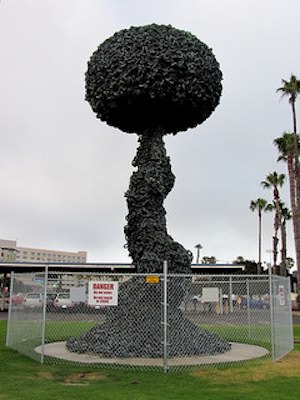
A sculpture, “Chain Reaction,” towers 26 feet above the Civic Center lawn in the Southern California coastal city of Santa Monica, a disturbing warning about the danger of nuclear arms. The artwork also brings back memories of bygone crusading journalism exemplified by the sculptor, the late Paul Conrad, Pulitzer Prize-winning cartoonist for the Los Angeles Times.
Conrad created “Chain Reaction” in 1991 and donated it to the city. It consists of chain links big enough to hold a large ship’s anchor, wrapped around a huge center post, reaching to a mushroom cloud, also made of chains. Across Main Street is the headquarters of the RAND Corporation, the think tank well known for its “Dr. Strangelove” Cold War research on survivability in a nuclear war. Not believing in such endurance, Conrad attached this message to the statue: “This is a statement of peace. May it never become an epitaph.”
I asked Conrad’s son David whether his father had neighboring RAND in mind when he chose the site. “That was icing on the cake,” David Conrad said.
Now the sculpture is in peril. The city, saying “Chain Reaction” is possibly hazardous and in need of repair, wants to move or even tear down the piece unless $400,000 is raised by February for renovation. Coincidentally, the piece is near an area, not far from the beach, that is a target for upscale development. I can see a prospective developer, thinking about putting up expensive condos, bistro bars and shops, looking at “Chain Reaction” and asking the city “how the hell will that thing fit in with my plans?”
I visited “Chain Reaction” recently on a perfect, clear day in Santa Monica, a city of more than 90,000 located on a wide bay of the Pacific Ocean. City officials had placed a chain link fence around the statue, saying they feared young people would climb on it.
My eyes were drawn upward by the interwoven chains to the mushroom cloud, spreading outward as the clouds did in New Mexico at the first test on July 16, 1945, and then at Hiroshima and Nagasaki. In a time when the nuclear threat, and the proliferation of the deadly weapons, is at the bottom of the news attention charts, it was good to see this reminder of the continued danger. I thought the chains symbolized not only the chain reaction needed to make the bomb, but the way we’re chained to the never-ending arms race and the wars meant to justify such waste.
There are no shades of gray in this statue. Conrad wasn’t ambiguous in his art. In person, he was a pleasant and sociable man, living with his family in the Palos Verdes Peninsula suburbs. He was a Little League coach, a golfer, a supporter of the Palos Verdes Art Center and an early male member of the League of Women Voters. But when he put his copy pencil to copy paper — now obsolete journalistic implements — for the first draft of his daily cartoon, he became a different Conrad, as if he were Clark Kent changing in to his Superman gear. He was unsparing in his scorn for those who deservedly made his gallery of villains.
Otis Chandler, the publisher who made the Times into a great newspaper, recruited Conrad from The Denver Post and supported him completely. The knowledge of such backing strengthened the third floor newsroom, where I worked, and in bureaus around the state, the country and the world. It was an era when reporters dug into the nation’s social and economic problems and were given time and resources to do the job. It wasn’t a perfect world, being largely white and male and, as is true with all enterprises, not without its share of incompetents. But in general, journalists were judged on the quality and depth of their work and not, as is the case today, on their number of followers.
The fact that “Chain Reaction” and RAND are neighbors points up the old relationship between journalism and the arms race.
There was a time when investigative journalists dug deeply into the frightening doctrine of mutual destruction. Robert Scheer, the editor-in-chief of Truthdig, exposed the thinking of RAND and its theoretician, Herman Kahn, in his exploration of the threat of nuclear war. Other reporters examined it too. In the age of Twitter, this kind of journalism seems as outmoded as Conrad’s pencils and copy paper.
There is still time to save “Chain Reaction.” Jessica Cusick, Santa Monica’s manager of cultural affairs, told me the statue is “not in any imminent danger of being moved or altered. That said, the council took action in February to allocate $50,000 for repair and the community groups have to raise the rest by next year.”
Money should not be a great obstacle. Santa Monica and its environs are among the wealthiest places in the country, with many affluent liberals, including fans of Paul Conrad. “Chain Reaction” should be preserved. It is a superb piece of public art, reminding us of the continuing nuclear arms race and of crusading journalists like Conrad.
Cartoonist Mr. Fish will be speaking with Truthdig Editor-in-Chief Robert Scheer about Paul Conrad, editorial cartooning and whatever else comes up Sunday, July 28 at 4 p.m. at the Robert Berman Gallery in Santa Monica.
Your support matters…Independent journalism is under threat and overshadowed by heavily funded mainstream media.
You can help level the playing field. Become a member.
Your tax-deductible contribution keeps us digging beneath the headlines to give you thought-provoking, investigative reporting and analysis that unearths what's really happening- without compromise.
Give today to support our courageous, independent journalists.

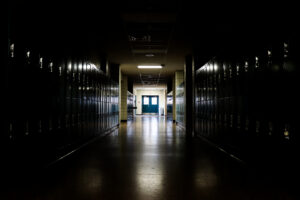
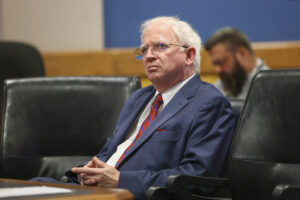
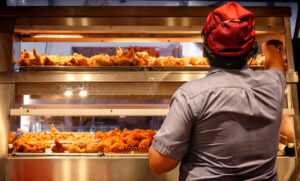
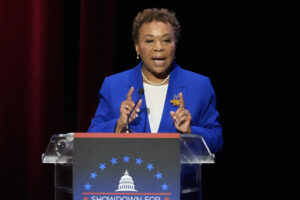
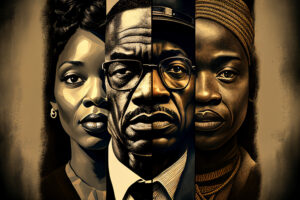
You need to be a supporter to comment.
There are currently no responses to this article.
Be the first to respond.